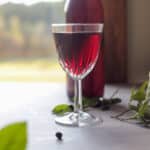How To Make Huckleberry Or Blueberry Wine
Everything you need to know to make a gallon of delicious huckleberry, blueberry, or huckleberry-blueberry Wine.
Servings: 25 glasses
Calories: 123kcal
Ingredients
- ½ lb black raisins (1 cup)
- 1½ lbs frozen huckleberries
- 1½ lbs frozen blueberries
- 1 fresh orange (juiced)
- 2¼ lbs granulated sugar
- 1 gallon water
- 1½ teaspoon acid blend
- ¼ teaspoon tannin
- ½ teaspoon pectic enzyme
- 3 Campden tablets, divided (crushed)
- ½ packet wine yeast (premiere blanc)
- ½ teaspoon Energizer
Optional
- ¼-⅓ cup huckleberry syrup (or juice)
- ½ teaspoon stabilizer (Potassium sorbate)
Instructions
Day 1
- Before beginning any fermentation process, you need to sanitize all of your equipment, work area, and hands.
- Chop raisins by hand or use a food processor and add either directly to the fermentor bucket or into a large mesh bag. Add frozen huckleberries and blueberries. If using a mesh bag, tie the bag to keep the raisins and berries contained in the bag. Add the juice of one orange.
- Add sugar to a large stockpot and cover with 1 gallon of water. Heat and stir until the water is hot and the sugar dissolves. Carefully pour the syrup over the berries and raisins. Mash the fruit using a potato masher to extract their juices. Allow the juice to come to room temperature.
- Next, add acid blend, tannin, pectic enzyme, and 1 crushed Campden tablet to the primary fermenter. Take the initial SG reading with a hydrometer. Cover the primary fermentation container with breathable fabric and use a rubber band to fasten it into place. Set the bucket aside for 24 hours.
Day 2
- Follow the instructions on the yeast packet to activate it. Since 1 packet is enough for 5 gallons, I only use ½ of the packet and save the rest for the next batch. Once active, add yeast and energizer to the "must" (unfermented fruit juice before it's converted to wine). Cover again and set aside.
Day 3+
- Stir daily and take the SG reading and record it. It should begin fermenting in 1-3 days which will be evident by the bubbles. When it reaches a specific gravity of 1.030 (it could take anywhere from 3-7 days) it's time to "rack the wine" (transfer it to a carboy).
- Strain and squeeze the juice out of the fruit in the straining bag. Save the berries for your compost bin. Transfer the wine to a one-gallon carboy. I use a funnel with a strainer to do this. Don't over-fill the carboy. Leave plenty of room for fermentation and bubbling.
- Fit sanitized bung into the opening of the bottle/bottles. Fill the airlock halfway with sanitizer solution or water and fit it into place. Store the carboy somewhere away from heat and direct sunlight. It will begin to bubble when fermentation starts, usually within a few hours.
- After 3 weeks to a month, use a siphon to transfer the wine into a clean plastic jug or fermentor bucket. Leave the sediment and cloudy wine at the bottom of the carboy behind. Add one crushed Campden tablet to the wine and stir to dissolve. Transfer the wine into a clean carboy. Allow the wine to clear anywhere from 1 to 3 months.
- Once the wine is completely clear, take a final SG reading to determine the alcohol percentage. If you don't like dry wine, it may need sweetening. If it's too dry, add anywhere from a ¼ cup to a ⅓ cup of huckleberry syrup, juice, or simple syrup. Give it a taste and add more if needed. Add another crushed Campden tablet (to keep the wine from oxidizing) and a ½ teaspoon of stabilizer (to prevent refermentation). Stir thoroughly!
- Use a siphon with a bottling wand (if you have one) to transfer the wine into sterilized bottles. Label the wine bottles with the type of wine, the date it was bottled, and the wine's alcohol content.
- The longer you allow the huckleberry wine to age the better it will be. Try to wait at least 3 months before tasting it but it's amazing after 12 months.
Notes
- Check out many more tips within the post!
- You can make this huckleberry-blueberry wine recipe as is or you can use 1 lb. huckleberries, 1 lb. serviceberries, and 1 lb. blueberries.
- Although you can use fresh blueberries and huckleberries, if possible, use frozen berries instead. The fruit's cell walls break down easier when frozen, which allows them to release more juice.
- When re-racking the wine, add the sediment at the bottom of the carboy to your compost bin, or dilute it with water and use it to water your plants.
- Don't fill the wine bottles all the way up the neck. Leave room for the corks. Alternatively, you can use flip-top bottles.
- The advantage of using a bottling wand is that it keeps the wine from spilling out of the tube. The wand is activated when pressure is applied to the bottom.
- When bottling the huckleberry-blueberry wine, you may end up with a bottle that's not all the way full. Save the extra wine in the fridge to enjoy. It won't be as good as aged wine, but it should still be good enough to drink. You can also add it to homemade spaghetti sauce.
- Huckleberry-blueberry wine goes great with cheese, desserts, and chocolate!
- The formula for figuring out the ABV: Original gravity reading - final gravity reading x 131.25 = ABV.
Nutrition
Serving: 1glass | Calories: 123kcal | Carbohydrates: 4g | Protein: 0g | Fat: 0g | Saturated Fat: 0g | Cholesterol: 0mg | Fiber: 0g | Sugar: 1g
